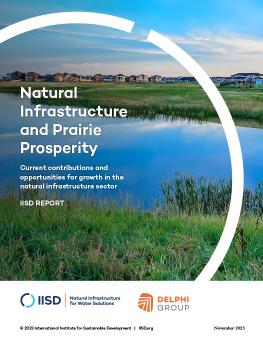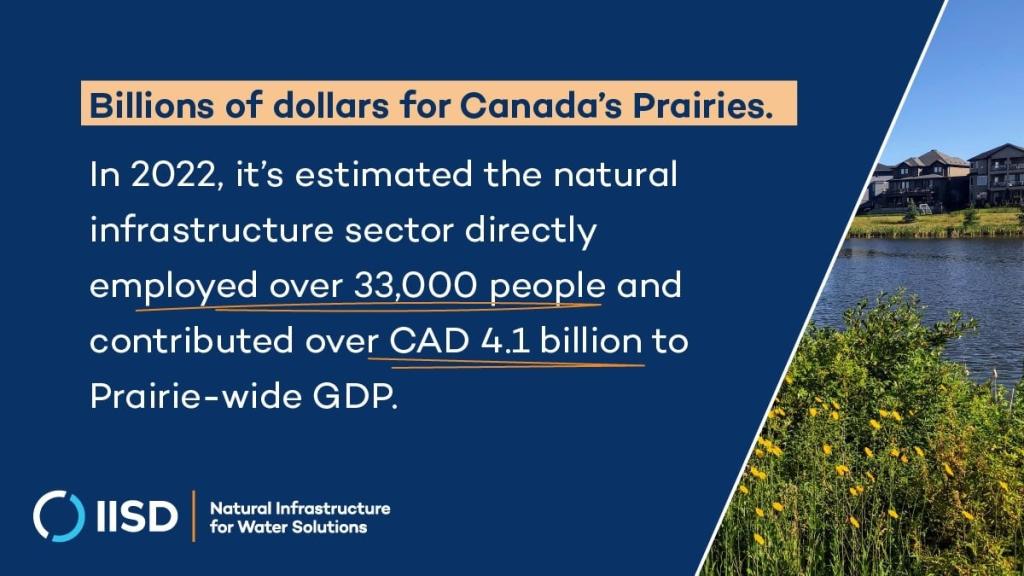
Natural Infrastructure and Prairie Prosperity
Current contributions and opportunities for growth in the natural infrastructure sector
The natural infrastructure sector contributes billions to the Prairie-wide economy and creates jobs. In 2022, the sector's direct contribution to the GDP of the Canadian Prairies was estimated to be CAD 4.1 billion, and it directly employed over 33,000 people in Alberta, Saskatchewan, and Manitoba. We need greater investment in this sector, which is required to treat and supply clean, fresh water to the millions who live in Canada's Prairies.
-
The natural infrastructure sector contributes billions to the Prairie-wide economy and creates jobs. We need more investment in this sector, which is required to treat and supply clean, fresh water to the millions who live on Canada's Prairies, as well as to protect them from natural disasters.
-
CAD 4.1 billion. The estimated direct contribution to the GDP of the Canadian Prairies in 2022 by the natural infrastructure sector. It's also estimated the sector directly employed over 33,000 people in Alberta, Saskatchewan, and Manitoba.
-
Natural Infrastructure investments support greater resiliency in the face of floods, droughts, fires, and other severe weather impacts-important across the Prairies, which faced devastating droughts and fires in 2023.
Natural infrastructure contributes over CAD 4 billion annually to the economy of Canada’s Prairies, as well as tens of thousands of jobs. There’s still room for growth: more investment can build greater resilience to droughts, floods, fires, and other severe weather impacts—many of which afflicted the region this summer—as well as increase jobs and GDP.
In Alberta, Saskatchewan, and Manitoba, it is estimated that this sector directly employed more than 33,000 people and contributed over CAD 4.1 billion to Prairie-wide GDP in 2022. With additional investments across the Prairie provinces of CAD 40 million to CAD 100 million per year, the sector could see between 18% and 25% in direct job growth by 2030 compared to business as usual.

Natural infrastructure involves the conservation, restoration, or enhancement of natural landscapes to provide specific results. For example, wetlands can naturally house excess water during floods; green roofs can help manage runoff; and forests, grasslands, and restored stream banks can replenish groundwater, mitigate flood- and drought-related risks, support fisheries, and provide opportunities for recreation. The sector employs a variety of workers, including landscape architects, ecologists, urban planners, stormwater managers, and environmental consultants.

Funded by
You might also be interested in
The State of Play of Natural Infrastructure on the Canadian Prairies
We sat down with key experts across the region and reviewed the latest literature to determine how we take natural infrastructure from novel to normal on Canada's Prairies.
How Can We Work With Nature to Tackle Drought and Desertification?
Drought is one of the most devastating and pervasive challenges exacerbated by climate change. However, we can work to reduce its effects through nature-based solutions for land restoration and climate-smart agriculture.
Estimate of Natural Infrastructure Public Grant Funding in Canada and in the Canadian Prairies
This analysis estimated the amount of public grant funding available across Canada and in the Canadian Prairie provinces for investing in urgently needed natural infrastructure.
Financing for Natural Infrastructure Projects
This report shows how private capital can finance natural infrastructure to meet our water needs, making financing decisions, and investment benefits.
